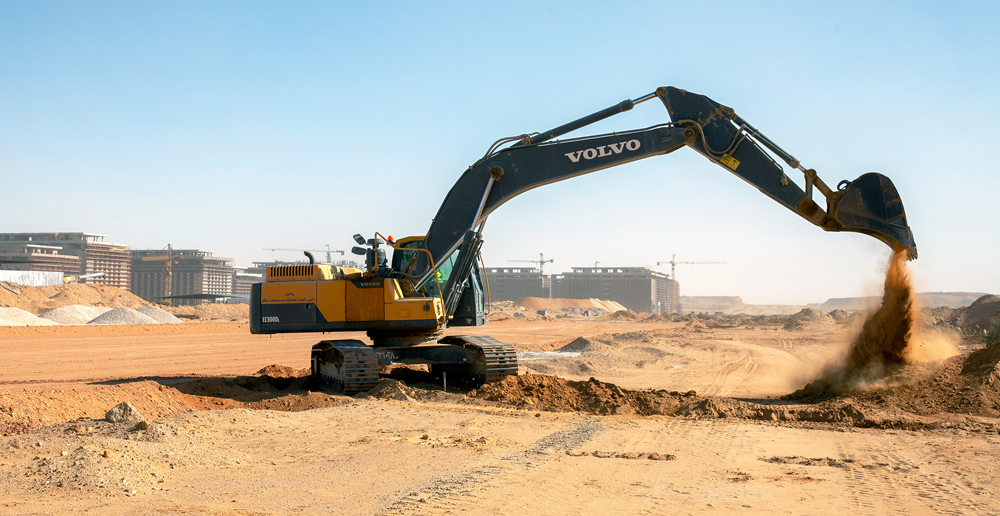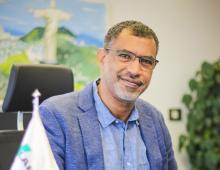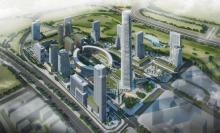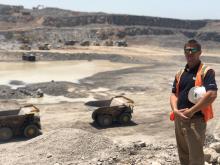
Egypt’s “New Administrative Capital” (NAC) was conceived in 2015 with the earmarked five-year $58bn construction works getting underway in 2017. The government decided to relocate the capital from Cairo to a new city, 35km east of the famous metropolis, due to rapid population growth. This growth is turning cities into powerful economic growth hubs, due to their ability to offer people easier access to education, jobs and other infrastructural facilities.
With tens of thousands of workers and hundreds of engineers toiling day in and day out and tonnes of building material, aggregates and cement pouring in from domestic and foreign sources, the new Egyptian capital is expected to be completed in a record time of five years. This compares very favourably with the 85 years that it reportedly took to build the great Pyramids of Giza.
The NAC will include Egypt’s parliament, 34 government ministries and a presidential complex, a new airport, a central business district (CBD), the 385m-high, 80-floor Iconic Tower which will be the tallest not only in Egypt but in the whole of Africa, and a park double the size of New York’s Central Park. Meanwhile, students will benefit from an array of cutting-edge facilities to be found in around 2,000 educational institutions. The new city will also include a technology and innovation park, over 1,000 mosques and 40,000 hotel rooms.
With over 70% of the infrastructure works for first phase of the NAC already completed at the beginning of this year, the government is set to move 34 government ministries — including the presidential complex — to the new capital in June 2020.
The entire NAC project is being supervised by Egypt’s President General Abdel Fattah Saeed Hussein Khalil El Sisi and other senior officials of the Egyptian Army.
A milestone
The China State Construction Engineering Corporation (CSCEC) is playing a key role in the development of a 20-tower central business district in the NAC. “The under-construction NAC is considered a milestone in Egypt’s development and modernisation, and the central business district is one of the most important projects of the new capital,” Chang Weicai, general manager of CSCEC Egypt, told the Chinese news agency, Xinhua.

Khaled Al Husseini, a senior government official, said that new-capital-first-phase construction work, including facilities and infrastructure, is set for completion in the first half of 2020. “The water facilities work at the new capital is now almost 95% over, while about 30% of the sewage system work has been finalised,” the spokesperson concluded.
Egyptian prime minister Dr Mostafa Madbouly has been a frequent visitor to the Iconic Tower in the central business district, visiting at least seven times. This indicates the government’s intense focus on the project. The prime minister also witnessed the mass concrete pouring of the Iconic Tower base in late February 2019 and regularly follows up the progress of the Iconic Tower erection, Chang added.
In another interview with the local English daily, Daily News Egypt, Administrative Capital for Urban Development (ACUD) chairman and CEO General Ahmed Abdeen said that the political leadership was keen on moving the ministries and agencies in time.
“The parliament will move in 2021 due to the beginning of its new legislative session in the same year. The building is huge and still in need of a lot of work. Moreover, the ACUD is preparing designs for Shura Council to be in the NAC,” he said.
Biggest purpose-built capital
Project Director for Volvo Construction Equipment (CE) Hub South (Middle East & Africa) Shahir El Essawy said that the new capital is planned to be the home of five million people - making it the biggest purpose-built capital in human history.
“Cairo has been Egypt’s capital for more than 1,000 years of the country’s 5,000-year history. But it is about to be dethroned from its position. The construction of the new capital began in 2017 and most government buildings started moving there from as early as 2019,” he said.
LafargeHolcim Group, a global leader in building materials and solutions, has supported several of NAC’s landmark projects with a total value of nearly $51 million. These projects include the Iconic Tower, Egyptian Cabinet building in the government district, two new metro lines in Cairo, the new Suez Canal tunnels and several port extensions.
For the Iconic Tower, the company is using an innovative and sustainable cement solution with higher slag contents to meet the contractor’s specifications. The solution is unique to the Egyptian market and provides an extended lifetime of more than 100 years thanks to its higher durability and strength, which are essential for a structure of this size and weight.
It is also the exclusive cement supplier for the tower’s base construction work, and in February this year poured concrete non-stop for 48 hours, the North African region’s longest-ever non-stop concrete pour.
Miljan Gutovic, head of LafargeHolcim Middle East Africa Region, said that to ensure materials were delivered reliably and on-time, a new concrete batching plant was installed on-site. Another one with an expected production capacity of 300,000m³ was opened at the end of Q1 2019.

Gutovic said LafargeHolcim was also taking the lead in quality control with its state-of-the-art local laboratory, where it can test both its own solutions as well as construction materials provided by other suppliers.
“With these important project wins, we continue our successful history of supporting large-scale construction projects across Egypt. These projects improve millions of lives by providing better infrastructure and housing,” he added.
The Egyptian government has not allocated any regular national budget funds to the NAC, instead mopping up resources via the sell-off of open plots. Of the total build area of 714km², the area for sale in the first phase of the NAC project is said to be 101km². Of that, 73.5km² has been sold. The other 27.5km² will be marketed until July 2020.
Leading Africa
In its Africa Construction Trends Report 2019 report, global consultancy firm Deloitte said that Egypt had the highest number and value of construction projects within a single African country in 2018, home to 9.5% of the continent’s builds during the year.
Egypt has 46 projects under construction, valued at $79.2bn, representing 17% of the total value of such developments in Africa. “Egyptian construction companies are the most visible private domestic firms, building 25 of the 35 private domestically constructed projects in North Africa,” the Deloitte report said.
At the end of 2018, Egypt’s population reached 100 million with only 6% of the land utilised. Moreover, Egypt is the most populous country in the Middle East and the third-most populous in Africa, with an annual population growth of 2.45%.
The Deloitte report added that there is a huge migration out of congested cities particularly in Cairo, fuelling the development of new communities by the private sector. Given the demographic pressure, more than 500,000 new residential units are required each year to keep up with existing demand, with the private sector delivering less than 15% of this figure.
Therefore, urbanisation and increased land utilisation is a priority for the government’s New Urban Communities Authority (NUCA), which aims to increase the percentage of land utilisation to 14% by the year 2050.
As a result of this current under-supply of housing and over-crowding in many major cities, the Egyptian Housing Ministry is planning to build some 20 new mega-cities covering a total area of 2,436km², with the aim of accommodating 30 million people. The new cities planned are in Cairo, Giza, Dakahlia, Beheira, Port Said, Matrouh, North Sinai, Beni Suef, Minya, Assuit, Qena, Luxor and Aswan, with the largest being the NAC. To overcome the huge shortage of housing in the country, the Housing Ministry will have to at least double the amount of land zoned for construction.
Huge demand
Executive chairman of the Egypt-based Metallurgical Industries Holding (MIH) Medhat Nafei said that they were working with some companies on new NAC contract bids and awaiting the results. He said there was huge demand for building materials for the megaproject which was mostly being procured from domestic suppliers.
Once completed, the new Egyptian capital will span an area larger than Madrid or Birmingham and will comprise a central park twice as long as New York’s and three times bigger than London’s Hyde Park. It will boast the tallest tower in Africa, the largest church in the Middle East and the biggest opera house outside Europe and will be home to six million people.
Proving pessimists wrong

Early in January 2020, Egypt’s Housing, Utilities and Urban Communities Minister Dr. Assem Abd el Ahmed Gazzar said that the NAC has become one of the most important cities in Egypt due to the transfer of government buildings and important facilities from Cairo to the new city this year.
“When we started planning for the New Administrative Capital, some questioned its importance, and others described it as a failed project, which is incorrect,” Gazzar told various media.
Referring to a 2010 study, Gazzar said that Egypt’s population may reach 160-180 million people by the year 2050 if current population growth rates continue.
He continued that a major problem lies in providing energy and water, especially since the vast majority of Egypt’s population is concentrated in regions that make up only 6 to 7% of the country’s total area.
As these regions are unable to support their residents economically, the housing sector must be doubled in response, Gazzar said, adding that 26% of land in Egypt can be developed.
Egypt’s new capital in figures
US$45-48BN: The initial estimated cost for the entire project
1.5 BILLION: The expected daily water use, in cubic metres in the new area
5,000,000: In the new capital there will be enough housing for over five million people
2022: The year when the project is expected to be completed
2,000: Number of schools and colleges in the new area
1,250: Number of new mosques and churches in the new capital
700: The new capital will stretch over 715 sq km
663:The new capital’s medical facilities
21: Residential districts in the new area
300: Developers working in the NAC
2203:Building permits issued for NAC projects










